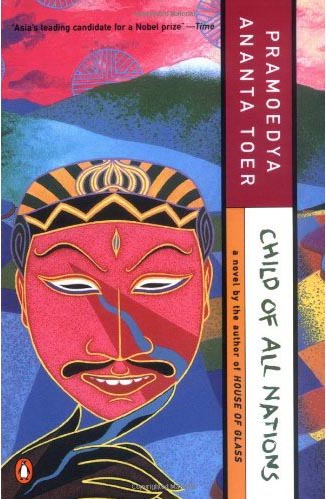Child of All Nations (Buru Quartet) by Pramoedya Ananta Toer

get from Amazon Child of All Nations
Child of All Nations (Buru Quartet)
From Booklist
Toer delivers the second volume of his Buru Tetralogy with devastating effect. Continuing with the characters of This Earth of Mankind (1991), the story focuses on Minke, a young, European-schooled Javanese writer--an "educated native"--fighting for his rights in the Dutch East Indies at the turn of the century. Minke is in the process of recovering from the death of his wife, who was murdered by Dutch colonials, and trying to assert his voice and the voices of his people. Everywhere he turns, the colonial forces and the all-powerful sugar companies build walls against his words. He struggles over which language to write in and which plights to address--there are so many languages, so many castes, and so many problems. In the end, Minke and his beloved mother-in-law are still trapped within their society but have gained a greater understanding of the possibilities of independence and stronger voices with which to shout. Ironically, this novel--and all of Toer's work--is banned in his native Malaysia. David Cline -- Dieser Text bezieht sich auf eine vergriffene oder nicht verfügbare Ausgabe dieses Titels.
From Kirkus Reviews
The second (This Earth of Mankind, 1991) in a quartet continues the often bittersweet story of the growing anticolonial movement in the Dutch-ruled Indonesia of the 1890's. As before, the novel is first told in oral form in a prison camp in 1973--a process that may be responsible for the uneven quality of the work, which veers from pedestrian passages on capitalism, colonialism, and local events to stunning vignettes of men and women destroyed by the pervasive Dutch presence. Minke, the narrator, picks up where he left off. His young wife, Annelies Mellema--daughter of a wealthy Dutch settler and a native concubine--has been sent to live in Holland--according to the terms of her father's will--and her marriage declared invalid. Then a grief-stricken Annelies dies, and back home Minke and mother-in-law Mama try to make new lives for themselves. Sometime journalist Minke plans to be a doctor, but friends like Jean Marais, a French artist, and Kommer, a mixed-blood--the Dutch, as they did in South Africa, specialized in racial classifications--advise him to write in Javanese, not Dutch, and to get to know the country people. Which he does in a desultory way: He learns how Dutch sugar planters stole land from the peasants; how a young woman deliberately infected herself with smallpox so that her Dutch master would die; and how the Mellema fortune itself is tainted. And in a series of set pieces--culminating in the stinging rebuke of colonialism that he and Mama deliver to the Mellema heir who's come from Holland to claim his inheritance--Minke begins to fight at last. A grand concept--as well as a searing indictment of an often cruel and malevolent regime--but Toer's agenda is more political treatise than a window into the human heart. -- Copyright ©1993, Kirkus Associates, LP. All rights reserved. -- Dieser Text bezieht sich auf eine vergriffene oder nicht verfügbare Ausgabe dieses Titels.
| Attachment | Size |
|---|---|
| Child.jpg | 68.27 KB |
- Editor1's blog
- Login to post comments